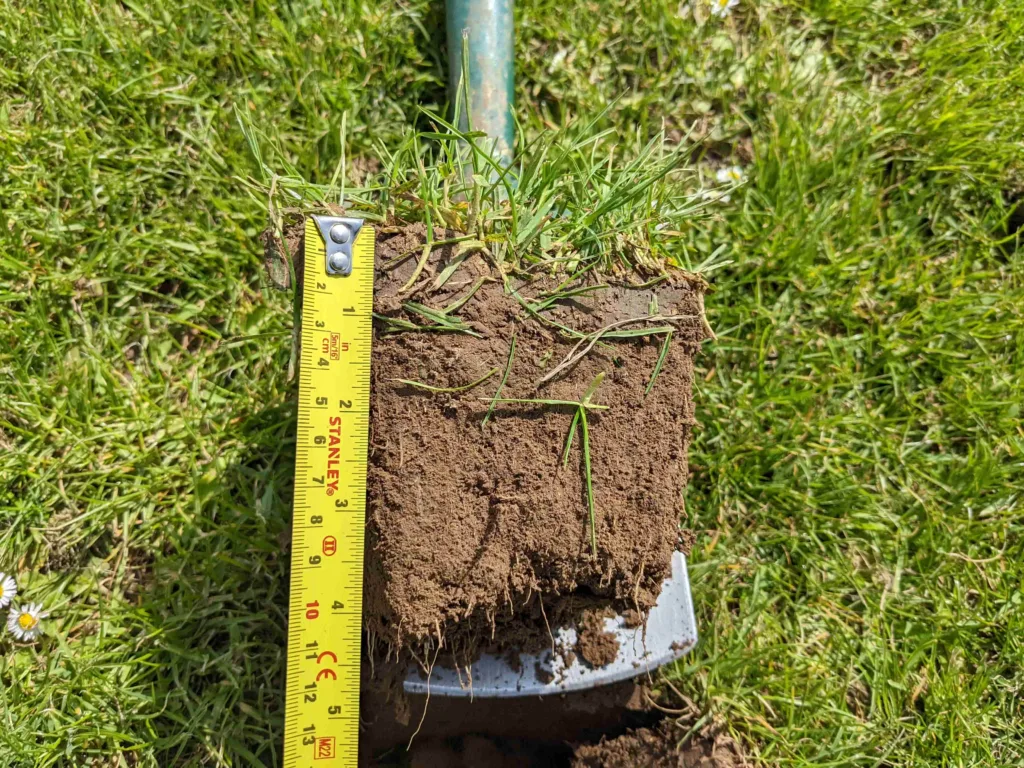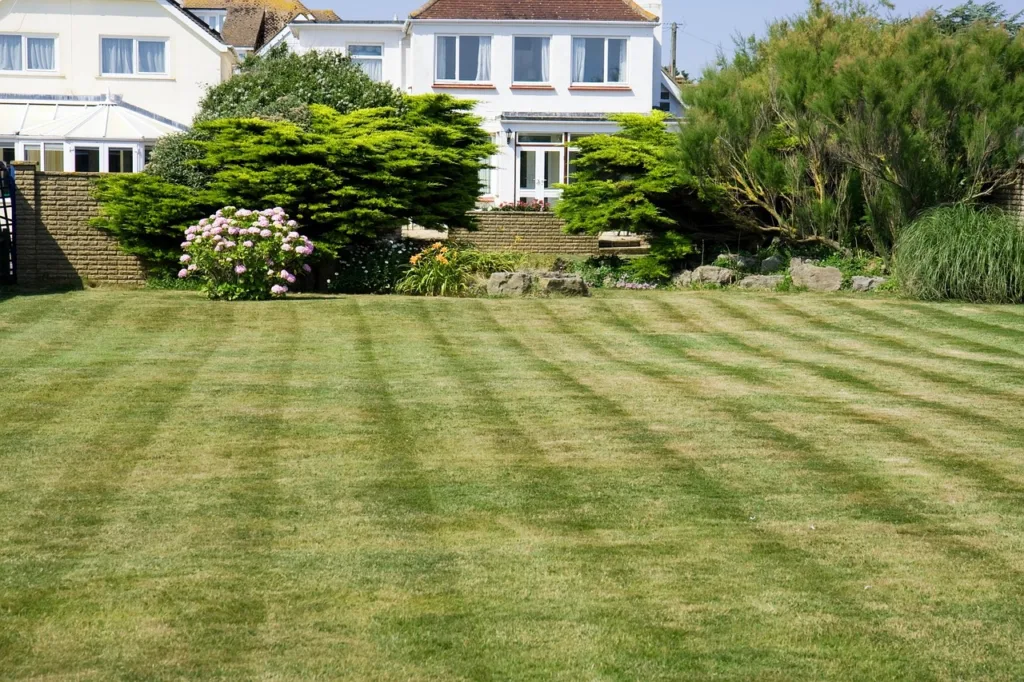Looking to buy grass seed for your lawn in the UK? Here’s everything you should consider to make sure you spend your money on the best grass seed for your specific situation.
Table of Contents
1. Is Your Lawn in Full Sun, Partial Shade, or Full Shade? 🌞
Start by getting a good understanding of your garden’s unique needs.
Sunlight is a key factor to consider, and different grasses vary in their sun requirements.
Sun-loving varieties thrive with at least six hours of direct sunlight daily. Ryegrass and some fescues fit this category. They germinate quickly and can withstand heavy use, making them ideal for family lawns.
On the other hand, shade-tolerant grasses, like fine fescues, can survive with just three to four hours of sunlight. These might be better suited for areas with limited sun exposure.
2. What’s Your Soil Type? ⛰
Soil type also plays a role in the type of grass seed that’s best for you.
Sandy soil drains well, but dries out quickly, so drought-resistant grasses like fescues or ryegrass mixtures are suitable in this scenario.
Clay soil can become waterlogged, so fine fescues or certain ryegrass varieties might work, but you may need to consider improving the soil first.
Loamy soil is the gardener’s dream: fertile and well-draining, it supports a wider range of grass seed options.
You can use a soil test to learn about your soil’s composition and help you choose the right seed.

3. How Much Water Does Your Lawn Get? 💦
Your watering habits and the UK’s unpredictable weather also influence your choice.
Let’s say you’re diligent about watering, particularly over those dry summer months (we’re talking your typical British two-week heatwave sometime between May and September). In this case, you have more options, including ryegrass mixtures or family lawn blends.
But if water is limited or you can’t be trusted not to forget about your lawn in the summer and end up killing it, drought-resistant fescues or ryegrass mixtures are better bets. Remember, even drought-resistant grass needs occasional watering, especially during dry spells.
4. How Big is your Lawn? 📏
Considering the size of your lawn is also essential when choosing grass seed. You want to make sure you get enough grass seed for your needs, but you don’t buy a bag that’s way too big and ends up getting forgotten about in your shed.
UK gardens usually have pretty modest lawns, but it’s still helpful to know how much seed you need for your lawn in advance.
Most grass seed packets will specify the coverage area per pack, so you’ll know how much grass seed you need once you’ve calculated your lawn’s square footage. We’ve got a handy lawn size calculator on our website to help you do just that.
It’s obviously better to have a slight surplus than to run out halfway through sowing, but there’s no need to go overboard!

5. How Do You Use Your Lawn? ⚽️
How you plan to use your lawn matters too when you’re choosing the best grass seed or seed mix for your situation.
If your garden is a family-friendly space, seeding or overseeding your lawn with a hardwearing, fast-repairing grass like a ryegrass mixture is ideal.
If you’re aiming for an ornamental lawn, bents or fine fescues might be your pick, but be prepared for more maintenance.
For a low-maintenance option that doesn’t prioritise aesthetics, consider wildflower lawn mixes or shade-tolerant fescue blends.
6. What Do You Want to Pay? 💰
Budget is another factor that will likely affect your choice of grass seed.
Ryegrass mixtures tend to be more affordable, while fine fescues and bents are often at the higher end of the price spectrum.
Remember, you can actually save money in the long run by investing in high-quality seed as you’ll need less to achieve a full lawn.
7. Additional Factors ➕
Beyond these basic considerations, other factors come into play. The germination rate of a particular seed type or seed mix is important; a higher rate means fewer seeds are needed. However, you’re not guaranteed to find this information on the box or packaging, so it’s a good idea to read customer reviews to get an idea of what to expect here.
Then you’ve also got the choice of going for a grass seed mixture or a single species of seed for your lawn. Seed mixes offer diversity, while single-variety seeds create a more uniform look that you may prefer.
Finally, make sure to consider factors like disease resistance, wear tolerance, and grass height when you’re making your choice.
Understanding Your Grass Seed Options 🧐
Now that you know the main factors that will influence your grass seed choice, let’s explore the different types available.
There’s no right or wrong option when it comes to grass seeds that are sold for lawns in the UK. Below, we’ve shared an overview of each common grass type and the key things you should know when you’re making your decision.
Ryegrass
Ryegrass is a popular option due to its rapid growth and resilience. Perennial ryegrass, in particular, is tough and ideal for family lawns. But this grass species can be susceptible to disease and doesn’t offer the finest texture.
Fescue
Fescue is a broader category that encompasses various types of grass. You’ve probably heard of fine fescue, creeping red fescue, and tall fescue.
Fine fescues tend to do best in shade and require minimal maintenance, making it a popular choice in mixes of grass seeds for UK lawns. These grass species create a dense, fine-textured lawn, albeit with a slower establishment.
Creeping red fescue, as the name suggests, has creeping rhizomes that make it ideal for establishing a dense, hardwearing lawn. Its creeping roots also help it to retain water and stay green even when it’s rooted in dry soil.
Tall fescue is more drought-tolerant and hardwearing, and is also often included in family lawn blends.
Bentgrass
Bentgrass has a fine texture and is a great option for creating a full, flawless turf.
It’s typically reserved for golf courses because it has its maintenance requirements, although it’s sometimes used in seed mixes for ornamental lawns.
Smooth-Stalked Meadow Grass
Finally, let’s give an honorary mention to smooth-stalked meadow grass (referred to as Kentucky Bluegrass by sellers in the US).
While it’s popular in other countries, meadow grass is less common in the UK. It’s known for its dark green color and fine texture and can be prone to diseases and weeds.
Grass Seed Mix
Most lawn seed products are actually mixtures of different grass types, which has a few advantages.
Blending various grasses means you can create a lawn that’s better equipped to handle different conditions. As a result, your lawn should have a thicker, more uniform appearance compared to if you just used a single grass species.
Another advantage is that different grasses have varying growth patterns, so a mix can provide a greener lawn for longer.
While seed mixtures are more commonly sold on marketplaces and in garden shops, you can still get your hands on single-variety seeds if you need them for something specific, like a garden putting green or a heavily shaded area.
🏁 Final Word
Hopefully, this article served as the introduction to grass seed in the UK that you were looking for.
If you want to see which grass seeds we specifically recommend for lawns in the UK, you can check out our best grass seed guide here.
Thanks for reading our blog post and happy gardening!
